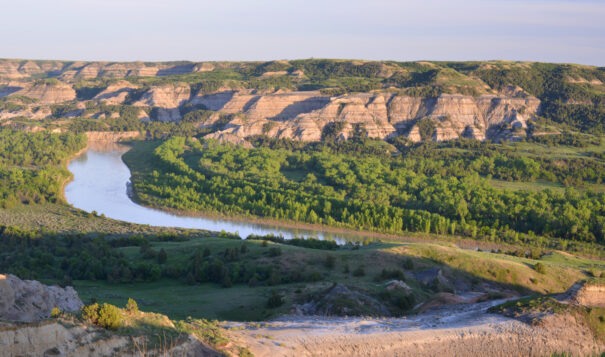News Based on facts, either observed and verified directly by the reporter, or reported and verified from knowledgeable sources.
Indian Country, MHA Nation, and North Dakota seeing results from the Bipartisan Infrastructure Law, including spotlight projects at Fort Berthold
 The BIL will bring significant repair to the North Dakota landscape. (Photo/Credit: Stock Image)
The BIL will bring significant repair to the North Dakota landscape. (Photo/Credit: Stock Image)
The United States Department of the Interior recently issued a press release outlining final guidance for Tribes on how to apply for the first $50 million in grand funding available under the Bipartisan Infrastructure Law, BIL, to clean up orphaned oil and gas wells. The BIL provides a total of $4.7 billion to address orphaned wells across the country – including $150 million for Tribal communities over five years. The final guidance is the result of a 60-day nation-to-nation consultation process.
According to the press release, there are several thousand orphaned oil and gas wells on Tribal lands, jeopardizing public health and safety by contaminating groundwater, seeping toxic chemicals, emit harmful pollutants including methane, and harm wildlife. Some of these wells exist underwater, creating an especially high risk of adverse impacts.
The BIL was passed on November 5, 2021, with a vote of 228-206 by the House. The BIL became effective November 15, 2021 – and will help rebuild America’s roads, bridges, and rails. The BIL will also expand access to clean drinking water, ensure every American has access to high-speed internet, tackle the climate crisis, advance environmental justice, and invest in communities that have been forgotten. In combination with the President’s Build Back Framework, the legislation will add an average of 1.5 million jobs per year for the next ten years.
The people of North Dakota are already seeing results from the BIL – with approximately $1.7 billion in funding announced for over 90 specific projects as of November 2022. Since being passed, North Dakota is set to receive more than $846 million for transportation to invest in roads, bridges, public transit, ports, and airports and over $130 million for clean water.
The Ports Project Spotlight in North Dakota highlights the Fort Berthold User Expansion. The Department of the Interior awarded the Garrison-Diversion Unit of the Pick-Sloan Missouri Basin Program $51 million to support the efforts associated with the Fort Berthold User Expansion project, as well as construction efforts associated to support services in the Northeast Segment Areas 3 and 4, the Spirit Lake West Service Area, and the Bear Soldier Service Area. A full list of Department of Interior projects announced earlier this year can be found here.
Additionally, Fort Berthold and the MHA Nation are featured in the Tribal Safety Project Spotlight. The United States Department of Transportation awarded $19.5 million in BIL funding to the North Dakota Department of Transportation for highway safety improvement projects on the Standing Rock Indian Reservation and the MHA Nation. These improvements include the installation of roundabouts, turn lanes, lighting, and rumble strips for improved safety on roadways in both Reservations. The safer roadways are expected to reduce delays, improve mobility, and connect the communities within these two reservations.
Across Indian Country, several projects are already underway, including South Dakota’s Pine Ridge Reservation/Oglala Dam Resilience Project Spotlight. The Department of the Interior awarded $22.6 million for repairs at Oglala Dam on the Pine Ridge Reservation. The dam experienced near failure in 2018 due to spillway deficiencies. The BIL funding will help complete the replacement of the spillway and outlet works, with a design already in progress.
By the time funding from the BIL is complete, the law will have made the single largest investment in Tribal infrastructure in United States history – with Tribal communities across Indian Country, including MHA Nation and Fort Berthold, benefiting from the landmark infrastructure law.
References:
US Department of the Interior, “Biden-Harris Administration Makes $50 Million Available to Clean Up Orphaned Oil and Gas Wells on Tribal Lands”, November 23, 2022, https://content.govdelivery.com/accounts/USDOI/bulletins/3398dac
Build.gov, North Dakota BIL State Fact Sheet, “President Biden’s Bipartisan Infrastructure Law is Delivering in North Dakota,” November 2022, https://www.whitehouse.gov/wp-content/uploads/2022/11/North-Dakota-BIL-State-Fact-Sheet-Nov-22.pdf
US Department of the Interior, “Final Tribal Grant Guidance,” Fiscal Year 2023, https://www.doi.gov/sites/doi.gov/files/fy23-tribal-grant-guidance-revised-final.pdf
Build.gov, BIL Tribal Fact Sheet, “President Biden’s Bipartisan Infrastructure Law is Delivering for Indian Country,” November 2022, https://www.whitehouse.gov/wp-content/uploads/2022/11/BIL-Tribal-Fact-Sheet_November-22.pdf
The White House, “President Biden’s Bipartisan Infrastructure Law,” https://www.whitehouse.gov/bipartisan-infrastructure-law/
